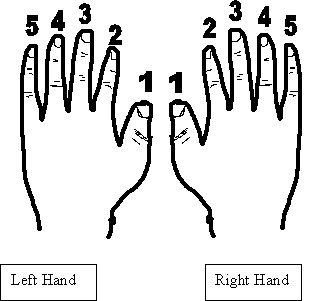A finger is a limb of the human body and a type of digit, an organ of manipulation and sensation found in the hands of humans and other primates.Normally humans have five digits, termed phalanges,on each hand (exceptions are polydactyly, oligodactyly and digit loss).
The first digit is the thumb, followed by index finger, middle finger, ring finger, and little finger or pinky.
Some other languages use the same generic term for all five digits of a hand.
English dictionaries describe finger as meaning either one of the five digits including the thumb, or one of the four excluding the thumb (in which case they are numbered from 1 to 4 starting with the index finger closest to the thumb).The first digit is the thumb, followed by index finger, middle finger, ring finger, and little finger or pinky.
Some other languages use the same generic term for all five digits of a hand.
Linguistically, it appears that the original sense was to include the thumb as a finger: the word is derived from penkwe-ros[citation needed] (also rendered as penqrós[citation needed]) which was, in the inferred Proto-Indo-European language, a suffixed form of penkwe (or penqe), "five", which has[citation needed] given rise to many Indo-European-family words (tens of them defined in English dictionaries) that involve or flow from concepts of fiveness.
Chimpanzees have lower limbs that are specialized for manipulation, and (arguably) have fingers on their lower limbs as well. The term 'finger' is not applied to the digits of most other animals, such as canines, felines, or ungulates, none of which can engage in fine manipulation with their forelimbs as a primate can.
Function
Each finger may flex and extend, abduct and adduct, and so also circumduct. Flexion is by far the strongest movement. In humans, there are two large muscles that produce flexion of each finger, and additional muscles that augment the movement. Each finger may move independently of the others, though the muscle bulks that move each finger may be partly blended, and the tendons may be attached to each other by a net of fibrous tissue, preventing completely free movement. This is particularly noticeable when trying to extend the third digit (middle finger) with the others flexed.
Fingers are usually moved under conscious control. In humans, they are used for grasping, typing, grooming, writing, caressing, and many other activities. They are also used in signaling, as when wearing a wedding ring, finger counting or when communicating in sign language.
Aside from the genitals, the fingertips possess the highest concentration of touch receptors and thermoreceptors among all areas of the human skin, making them extremely sensitive to temperature, pressure, vibration, texture, and moisture. Thus fingers are commonly used as sensory probes to ascertain properties of objects encountered in the world, and so they are prone to injury.
Fingers do not contain muscles other than arrector pili muscles. The muscles that move the finger joints are in the palm and forearm. The long tendons that deliver motion from the forearm muscles may be observed to move under the skin at the wrist and on the back of the hand.
Fingers
Each of the fingers has unique cultural and functional significance. From the thumb on the radial side to the ulnar side of the hand, the fingers are in this order:
Each of the fingers has unique cultural and functional significance. From the thumb on the radial side to the ulnar side of the hand, the fingers are in this order:
|
Anatomy
The 5 digits are attached to the forearm by a joint called the wrist (carpus).
The thumb (connected to the trapezium) is located on one of the sides, parallel to the arm.
Illustration depicting the bones of the human hand
The palm has five bones known as metacarpal bones, one to each of the 5 digits. Human hands contain fourteen digital bones, also called phalanges, or phalanx bones: two in the thumb (the thumb has no middle phalanx) and three in each of the four fingers. These are the distal phalanx, carrying the nail, the middle phalanx, and the proximal phalanx.
Sesamoid bones are small ossified nodes embedded in the tendons to provide extra leverage and reduce pressure on the underlying tissue. Many exist around the palm at the bases of the digits; the exact number varies between different people.
The articulations are: interphalangeal articulations between phalangeal bones, and metacarpophalangeal joints connecting the phalanges to the metacarpal bones.
The pulp of a finger is the fleshy mass on the palmar aspect of the extremity of the finger.
Muscles
 |
| Muscles and other structures of wrist and palm |
Muscles of the fingers can be subdivided into two groups: the extrinsic and intrinsic muscle groups. The extrinsic muscle groups are the long flexors and extensors. They are called extrinsic because the muscle belly is located on the forearm.
The intrinsic muscle groups are the thenar and hypothenar muscles (thenar referring to the thumb, hypothenar to the small finger), the interossei muscles (between the metacarpal bones, four dorsally and three volarly) and thelumbrical muscles. These muscles arise from the deep flexor (and are special because they have no bony origin) and insert on the dorsal extensor hood mechanism. The intrinsic muscles of hand can be remembered using themnemonic, "A OF A OF A" for, Abductor pollicis brevis, Opponens pollicis, Flexor pollicis brevis, Adductor pollicis (thenar muscles) and Opponens digiti minimi, Flexor digiti minimi brevis, Abductor digiti minimi (hypothenar muscles).
The fingers have two long flexors, located on the underside of the forearm. They insert by tendons to the phalanges of the fingers.
The deep flexor attaches to the distal phalanx, and the superficial flexor attaches to the middle phalanx. The flexors allow for the actual bending of the fingers. The thumb has one long flexor and a short flexor in the thenar muscle group. The human thumb also has other muscles in the thenar group (opponens and abductor brevis muscle), moving the thumb in opposition, making grasping possible.
The extensors are located on the back of the forearm and are connected in a more complex way than the flexors to the dorsum of the fingers. The tendons unite with the interosseous and lumbrical muscles to form the extensorhood mechanism. The primary function of the extensors is to straighten out the digits.
The thumb has two extensors in the forearm; the tendons of these form the anatomical snuff box. Also, the index finger and the little finger have an extra extensor, used for instance for pointing. The extensors are situated within 6 separate compartments. The 1st compartment contains abductor pollicis longus and extensor pollicis brevis. The 2nd compartment contains extensors carpi radialis longus and brevis. The 3rd compartment contains extensor pollicis longus. The extensor digitorum indicis and extensor digititorum communis are within the 4th compartment. Extensor digiti minimi is in the fifth, and extensor carpi ulnaris is in the 6th.
The deep flexor attaches to the distal phalanx, and the superficial flexor attaches to the middle phalanx. The flexors allow for the actual bending of the fingers. The thumb has one long flexor and a short flexor in the thenar muscle group. The human thumb also has other muscles in the thenar group (opponens and abductor brevis muscle), moving the thumb in opposition, making grasping possible.
The extensors are located on the back of the forearm and are connected in a more complex way than the flexors to the dorsum of the fingers. The tendons unite with the interosseous and lumbrical muscles to form the extensorhood mechanism. The primary function of the extensors is to straighten out the digits.
The thumb has two extensors in the forearm; the tendons of these form the anatomical snuff box. Also, the index finger and the little finger have an extra extensor, used for instance for pointing. The extensors are situated within 6 separate compartments. The 1st compartment contains abductor pollicis longus and extensor pollicis brevis. The 2nd compartment contains extensors carpi radialis longus and brevis. The 3rd compartment contains extensor pollicis longus. The extensor digitorum indicis and extensor digititorum communis are within the 4th compartment. Extensor digiti minimi is in the fifth, and extensor carpi ulnaris is in the 6th.
Anomalies and diseases
 |
| Radiograph of Type 1 Syndactyly |
A rare anatomical variation affects 1 in 500 humans, in which the individual has more than the usual number of digits; this is known as polydactyly. A human may also be born without one or more fingers or underdevelopment of some fingers such as symbrachydactyly. Extra fingers can be functional. One individual with seven fingers not only used them but claimed that they “gave him some advantages in playing the piano.
Phalanges are commonly fractured. A damaged tendon can cause significant loss of function in fine motor control, such as with a mallet finger.
Finger locking is the act of locking the middle joint of a finger in place, and bending the very last joint independently from the others. Many people have the ability to do this in only one hand or even in both, depending on how the muscles are formed in the hand. Finger locking may cause pain.
The fingers are commonly affected by diseases such as rheumatoid arthritis and gout. Diabetics often use the fingers to obtain blood samples for regular blood sugar testing. Raynaud's phenomenon is a neurovascular disorder that affects the fingers.
 |
| Joint finger |
Research has linked the ratio of lengths between the index and ring fingers to
higher levels of testosterone, and to various physical and behavioral traits such as penis length and risk for development of alcohol dependence.
Each finger has an orderly somatotopic representation on the cerebral cortex in the somatosensory cortex area 3b,part of area 1and a distributed, overlapping representations in the supplementary motor area and primary motor area.
higher levels of testosterone, and to various physical and behavioral traits such as penis length and risk for development of alcohol dependence.
Brain representation
Each finger has an orderly somatotopic representation on the cerebral cortex in the somatosensory cortex area 3b,part of area 1and a distributed, overlapping representations in the supplementary motor area and primary motor area.
The somatosensory cortex representation of the hand is a dynamic reflection of the fingers on the external hand: in syndactyly people have a clubhand of webbed, shortened fingers.
However, not only are the fingers of their hands fused, but the cortical maps of their individual fingers also form a club hand.
The fingers can be surgically divided to make a more useful hand. Surgeons did this at the Institute of Reconstructive Plastic Surgery in New York to a 32-year-old man with the initials O. G.. They touched O. G.’s fingers before and after surgery while using MRI brain scans. Before the surgery, the fingers mapped onto his brain were fused close together; afterward, the maps of his individual fingers did indeed separate and take the layout corresponding to a normal hand.
However, not only are the fingers of their hands fused, but the cortical maps of their individual fingers also form a club hand.
The fingers can be surgically divided to make a more useful hand. Surgeons did this at the Institute of Reconstructive Plastic Surgery in New York to a 32-year-old man with the initials O. G.. They touched O. G.’s fingers before and after surgery while using MRI brain scans. Before the surgery, the fingers mapped onto his brain were fused close together; afterward, the maps of his individual fingers did indeed separate and take the layout corresponding to a normal hand.









































0 comments